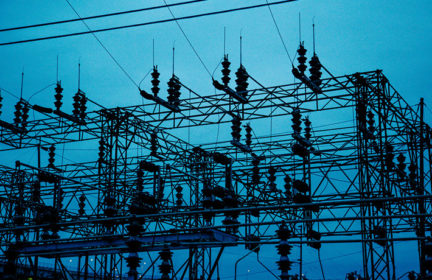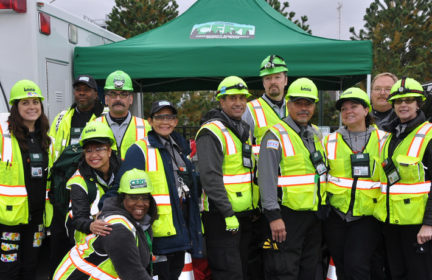Here comes the sun – When a massive solar flare, grid loss and overheated nuclear reactors change the world. [Edited to include what the prepper in the story did wrong.]
Solution for what the prepper did wrong at the end of the post.
This morning, you watch as the sun shoves the sky aside and plants itself in your line of vision. Sunrise. No one cares much for sunrise these days.
Thirteen months have passed since your world went silent and dark.
The massive solar storm stopped the world dead in its tracks. It destroyed the vulnerable electric power grid transformers. There had been a committee back in 2011 that had examined the risks and warned action was needed. It was too late now.
You listen. Nothing. At one time the sound of traffic and horns honking was an annoyance. Now, you would give today’s ration of food to hear a car or sip a warm beverage, or linger with a good book while sitting on a gleaming white porcelain toilet that actually flushed. When the grid was destroyed, it took sewage, sanitation and potable water along with it.
At first, they said restoration would happen in months, then months became “foreseeable future.” There was some irony for you in that phrase. No one was seeing much of anything these nights. It was pitch black at night now.
You try to remember the smell of coffee in the morning. You haven’t made coffee for three months since your supply of fuel ran out. You should have stocked more fuel or searched for better alternatives while you had the chance to do so.
Has it only been 13 months? It feels like an eternity has passed since the sun threw a massive solar tantrum larger than the Carrington Event of 1859.
The event was the solar flare equivalent of the big earthquake on the San Andreas fault predicted by seismologists.
Some reports said a solar storm wouldn’t have the deleterious effects upon communications and electronics that everyone feared.
The misinformation about solar flares and the electro magnetic pulses were fed partly by the entertainment industry.
People mocked those who doggedly prepared for a solar storm event because they didn’t understand how a solar storm would affect the power grid.
Severe solar storms only produce an E3 element that takes out the power grid transformers, and initiates DC like currents in extremely long electrical conductors.
Solar storms don’t produce the rapid E1 element that damages electronics. It was the loss of power that rendered electronics useless.
No one considered the threat that would result from long term power loss and it’s effect upon nuclear power plants. When those effects became apparent, everyone suddenly remembered Chernobyl and Fukashima.
The early days of blackout conditions and the subsequent looting and rioting was nothing compared to the long term effects of grid loss and the reactions of the nuclear power plants.
Then the psychological illness started, people who hadn’t prepared couldn’t cope with the utter devastation of their electronic world. They were overwhelmed by the disruption to all the modern conveniences integrated into their lives. You could see it in their eyes. They were not just hungry and dirty. They were lost also. Some of them became fatalistic and murderous in their insanity and very dangerous.
You need to forage. Maybe someone missed something in the mosaic of abandoned cars that litter the roadways and streets. But, you need to go further away from home to do so. It’s a big risk taking the bicycle out. Bicycles are like gold now and people have been killed for them.
You lace your boots up and whisper “thank you” to a prepper on The Prepared who taught you about FLC: feet, leather, covered.
You made sure to have the best boots you could afford. After testing them, you bought two extra pairs of those boots plus repair materials and learned how to repair them to extend their life. It wasn’t just a prep for a long duration event. You knew that sometimes really good quality items stopped being made or began to be made with inferior materials or workmanship.
Footwear was an important prep and the limping, poorly shod people roaming about were grim reminders. Some people with bad footwear were getting infected feet. Gangrene was nothing to fool with.
Save the bicycle for when it’s time to bug out. On The Prepared, you learned about The Monowalker from a UK prepper. It was carefully stored and ready to be used for bug out. Another “thank you.”
You wondered if the people from The Prepared were alive, if they and their families were okay. You hoped that however they prepared, that it was enough. You hoped that an experimental gardener with the dogs and gardens was picking ju-jubes and that there was a pound cake on their table.
It had become tougher to forage as more and more desperate people scavenged, while predator survivors waited in the shadows to take what they found.
Gun fights were common and avoiding stray bullets was a new pastime. When bullets hit your home, you moved your bed away from the outer walls and slept in a room lined with bookcases for protection.
Today, you could assemble a travois to carry larger or heavier items as close as possible, then “cache and carry” under cover of darkness. You needed to assemble more barter items to get the supplies you lacked for the long bug out journey ahead.
It was almost “bug-out o’clock.” Your personal doomsday clock was ticking louder. Bug out was your last resort, but survival is and always will be your first resort.
The bug out option became more complicated after the reactors overheated. It was a part of prepping that many preppers hadn’t factored.
There were now fewer options unless you wanted to glow in the dark. You had heard the radiation wasn’t as bad at the West Coast. “Heard!” How could you have forgotten to print the map for predicted reactor drift? You printed all your other important prep info!
The chorus of regret began to rise and flow toward your amygdala where it would soon become panic. NO!
Focus. Stay focused and aware. Get through today. Do it thirty seconds at a time if necessary, but get through today alive. You can do this. You can make it.
Internal pep talk concluded, you sling your dummy pack over one shoulder and do a final pat down and run a mental check list from head to feet of everything stashed on your person. The dummy pack was just some crumpled paper, empty tin cans, and a couple of rocks in a bag, but it was a way to blend in, foil robbers and useful as an improvised weapon.
What’s left of your guns and ammo is reserved for the long road ahead.
You think of The Prepared and everyone there who became an online community of preppers. You whisper the words into the air, “wherever you are, I hope you survived and if I make it, it will be because of all of you.”
Go time. You step out into the sun and begin to walk.
How could you become better prepared for a severe solar storm, long term loss of the power grid and the potential impact upon the nuclear power plants?
https://www.futurescience.com/emp.html
https://phys.org/news/2011-03-nuclear-meltdown-video.html
https://www.sustainabilitytelevision.com/blog/400-chernobyls-solar-flares-emp-and-nuclear
https://earthsky.org/space/how-likely-space-super-storms-solar-flares-carrington-event
https://www.scientificamerican.com/article/new-studies-warn-of-cataclysmic-solar-superstorms/
https://www.govinfo.gov/content/pkg/CHRG-112hhrg80856/html/CHRG-112hhrg80856.htm
http://plainshumanities.unl.edu/encyclopedia/doc/egp.tra.038 travois
Here’s what the prepper in the story did wrong.
This scenario was meant to illustrate the power grid loss and reactor issues, but there was another message left in clues throughout the story.
The story is set thirteen months after the event in an urban area based on the number of people roaming about.
The person in the story is alone without any community established either before or after the event occurred. We’ll call this person the prepper.
The prepper claims to have not made coffee for three months which would place their last coffee ten months after the event happened. Making coffee with its distinct aroma was a mistake from the beginning.
The coffee should have been saved to drink cold if in need of caffeine to stay alert. This prepper was low on fuel, yet they still wasted fuel on a cup of coffee. That fuel might have been needed to boil water and sterilized equipment for first aid purposes.
Next, the prepper admits not prepping enough fuel or alternates which are part of needs, not wants in prepping. Water, food, shelter, defense, clothing, warmth, and first aid are needs, not “nice to haves.”
The prepper clearly describes the psychological condition of the population, yet is still sheltering in place without adequate community or resources.
The prepper describes needing to forage and having to go further away because vehicles in close proximity have been picked clean. This is now done on foot and without the bicycle. How does he plan to get that bicycle and Monowalker out of there without being noticed at this late stage?
Bicycles may be considered gold in the scenario, but so are boots according to the story with people needing them. He should have been “public” in an old pair that he could afford to lose.
The pepper refers to The Prepared and people that he learned from, yet has failed to see that the need for bug out happened long ago. Would this have happened with other people/family around? Is the isolation affecting this person’s judgement? Is there a lesson for all of us regarding isolation?
The prepper refers to “predator survivors” stealing from other survivors. No one should remain in that environment, nor in an environment with “gun fights” that are “common.” “Avoiding stray bullets” should not be a preppers “pastime.”
The prepper in the story wants to scavenge and possibly “cache and carry” items with which to barter to get supplies he “lacks” for the long bug out journey ahead. If he was prepared, why is he lacking important items?
Whom does he plan to barter with? It doesn’t sound like people around him are doing very well and barely surviving. If they did have what he needed, he could have bartered the boots he was wearing and worn his brand new back up pair without risking a foraging trip.
There are survivor predators and he thinks that he can just breeze past them with his foraged items? They would be out a night also and he will have trouble seeing them until it is too late.
The prepper is wasting more time and energy and running more risk in this fruitless exercise that he is mistaking for survival.
It no longer matters that bug out was a “last resort.” Now it should be his first resort if he wants to survive.
The prepper doesn’t have any maps.
The reference at the end to “what’s left of your guns and ammo” is troubling. How much shooting was this prepper doing? If you are alone and have to shoot that much, you shouldn’t be there. Why waste ammo when the solution is to exit a no win situation.
We assemble items, information, plan and prepare, but in an actual disaster we need to be careful of our judgement.
Hanging onto preconceived ideas that are clearly no longer working for us in a disaster, is a dangerous strategy, especially if we are alone and there is no one else to challenge our thinking.
Sometimes, our judgement can be faulty. We may, like the person in the story, remain far too long SIP, when we should have been long gone.
We may also place priority on having items that are not necessary or wasting resources in order to have “the comforts of home.”
Bugging out is not a camping trip. It is becoming a refugee to save your life, so take with you what will actually help you to survive.
One final note on the cars, the prepper in the story did not check the mass of vehicles for one made in an era (80’s) which from my newly formed understanding, would not have sustained damage during the solar flare. A bit of siphoning, stash bug out items, and if no keys, hot wire and go.
-
Comments (30)
-


